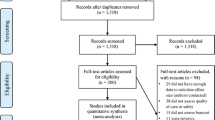Abstract
The development of a detailed model of substance-abuse treatment (SAT) staff performance is described. The model describes the key behaviors of SAT staff. Specifically, researchers used the critical incident technique to develop the model, which includes a total of 15 dimensions, nested under four meta-dimensions: providing clinical services, employee citizenship behaviors, providing clinical support, and managerial behavior. Development and validation of a measure based on the model are also described. More than 600 SAT staff members in 51 SAT agencies completed the new measure. Factor analyses supported the measure’s hypothesized dimensional structure; high internal consistency reliabilities were observed for all scales; and interrater agreement metrics indicated an acceptable level of within-agency agreement. Moreover, the measure correlated in expected and theoretically consistent ways with measures of job satisfaction and other job-related opinions.
Similar content being viewed by others
References
Gerstein DR, Johnson RA, Foote ML, et al. Evaluating Recovery Services: The California Drug and Alcohol Treatment Assessment (CALDATA) Methodological Report. Chicago: National Opinion Research Center; 1994.
Holder HD, Blose JO. The reduction of health care costs associated with alcoholism treatment: a 14-year longitudinal study. Journal of Studies on Alcohol. 1992;53:293–302.
Donabedian A. Evaluating the quality of medical care. Milbank Memorial Fund Quarterly. 1966;44:166–203.
Donabedian A. Quality of care: how can it be assessed? Journal of the American Medical Association. 1988;260:1743–1748.
Austin JT, Villanova P. The criterion problem: 1917–1992. Journal of Applied Psychology. 1992;77:836–874.
Guion RM. Assessment, Measurement, and Prediction for Personnel Decisions. Mahwah: Erlbaum; 1998.
McCorry F, Garnick DW, Bartlett J, et al. Developing performance measures for alcohol and drug services in managed care plans. Journal on Quality Improvement. 2000;26:633–643.
Zanis DA, McLellan AT. Ensuring quality in the treatment of chemical dependency. In: Stricker G, Troy WG, et al, eds. Handbook of Quality Management in Behavioral Health. Issues in the Practice of Psychology. New York: Kluwer; 2000:193–215.
American Society of Addiction Medicine. PPC-2: Patient Placement Criteria for the Treatment of Substance-Related Disorders, 2nd edn. Chevy Chase: ASAM; 1996.
Lenox RD, Mansfield AJ. A latent variable model of evidence-based quality improvement for substance abuse treatment. Journal of Behavioral Health Services & Research. 2001;28:164–176.
Moos RH. Evaluating Treatment Environments: The Quality of Psychiatric and Substance Abuse Programs. New Brunswick: Transaction; 1997.
Moos RH. Addictive disorders in context: principles and puzzles of effective treatment and recovery. Psychology of Addictive Behaviors. 2003;17:3–12.
National Institute on Drug Abuse. Principles of Drug Addiction Treatment. A Research Based Guide. Rockville: NIDA; 1999 DHHS Pub. No. (ADM)99–4180.
Anderson L, Wilson S. Critical incident technique. In: Whetzel DL, Wheaton GR, eds. Applied Measurement Methods in Industrial Psychology. Palo Alto: Davies-Black; 1997.
Flanagan JC. The critical incident technique. Psychological Bulletin. 1954;51:327–358.
Harvey RJ. Job analysis. In: Dunnette MD, Hough LM, eds. Handbook of Industrial and Organizational Psychology, 2nd ed., vol. 2. Palo Alto: Consulting Psychologists Press; 1990:71–163.
Kemppainen JK. The critical incident technique and nursing care quality research. Journal of Advanced Nursing. 2000;32:1264–1271.
Longo B, Connor G, Barnhart T. Using the critical incident survey to assess hospital service quality. Journal of Hospital Marketing. 1993;7:91–100.
Adams KA, Goodwin GF, Searcy CA, et al. Development of a Performance Model of the Medical Education Process (Technical Report). Washington, DC: American Institutes for Research; 2001.
Dumas JS, Redish JC. A Practical Guide to Usability Testing. Norwood: Ablex; 1993.
Ironson GH, Smith PC, Brannick MT, et al. Construction of a Job in General Scale: a comparison of global, composite, and specific measures. Journal of Applied Psychology. 1989;74:193–200.
Spector PE. Job Satisfaction: Application, Assessment, Causes, and Consequences. Thousand Oaks: Sage; 1997.
Mael FA, Ashforth BE. Alumni and their alma mater: a partial test of the reformulated model of organizational identification. Journal of Organizational Behavior. 1992;13:103–123.
Riketta M. Organizational identification: a meta-analysis. Journal of Vocational Behavior. 2005;66(2):358–384.
Landau J, Hammer TH. Clerical employees’ perceptions of intraorganizational career opportunities. Academy of Management Journal. 1986;29:385–404.
Hatcher L. A Step-by-Step Approach to Using the SAS® System for Factor Analysis and Structural Equation Modeling. Cary: SAS Institute; 1994.
Hoyle RH. Structural Equation Modeling: Concepts, Issues, and Applications. Thousand Oaks: Sage; 1995.
Browne MW, Cudek R. Alternative ways of assessing model fit. In: Bollen KA, Long JS, eds. Testing Structural Equation Models. Beverly Hills: Sage; 1993:136–162.
Bliese PD. Within-group agreement, non-independence, and reliability: implications for data analysis and aggregation. In: Klein KJ, Kozlowski SWJ, eds. Multilevel Theory, Research, and Methods in Organizations. San Francisco: Jossey-Bass; 2000:349–381.
Campbell JP, McCloy RA, Oppler SH, et al. A theory of performance. In: Schmitt N, Borman WC, eds. Personnel Selection in Organizations. San Francisco: Jossey-Bass; 1993:35–70.
Acknowledgments
This research was graciously supported by a grant from the National Institute on Drug Abuse (NIDA), Grant R01-DA015484. Portions of this work were presented at the 113th Annual Conference of the American Psychological Association (APA) held in Washington, DC (August, 2005) and the 11th International Conference on Treatment of Addictive Behaviors (ICTAB) held in Santa Fe, NM (January–February, 2006). We express our appreciation to the county directors of Kern, Contra Costa, San Mateo, Alameda, and Madera (California) and Baltimore, Prince George’s, and Howard (Maryland) for their assistance at all stages of data collection. We also thank Dennis McCarty, Steve Jex, John Michela, Rick Sampson, and Christine Timko for their useful input at various stages of this project.
Author information
Authors and Affiliations
Corresponding author
Rights and permissions
About this article
Cite this article
Mael, F.A., O’Shea, P.G., Smith, M.A. et al. Development of a Model and Measure of Process-Oriented Quality of Care for Substance Abuse Treatment. J Behav Health Serv Res 37, 4–24 (2010). https://doi.org/10.1007/s11414-009-9180-4
Published:
Issue Date:
DOI: https://doi.org/10.1007/s11414-009-9180-4




